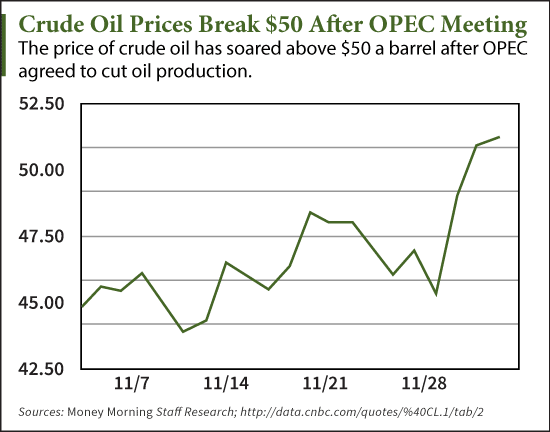We've just released a new oil price prediction now that OPEC has agreed to slash production, and we are predicting double-digit gains.
WTI crude oil prices have already climbed above $50 a barrel after the November OPEC meeting ended in an official deal to cut oil production. The chart below shows how the price of oil rose sharply after the deal was announced.
Because the new OPEC agreement was such a big deal, we've made a new oil price prediction. Before we get to our new oil price target, here's why the November OPEC meeting was so crucial for oil prices...
What the Vienna OPEC Agreement Means for Oil Prices
There are two main reasons the OPEC agreement has made investors optimistic about the price of crude oil.
First, OPEC members agreed to cut oil production from its current level of 33.6 million barrels a day to 32.5 million barrels a day. That's a reduction of more than 3%.
Reduced oil production will help curb oil supply and raise oil prices if demand remains steady. Low oil prices mean less revenue for oil-exporting countries, so boosting prices has been a necessity for the cartel.
Don't Miss: Get the Best Investing Research Today to Grow Your Money
The second, and potentially bigger, reason investors are optimistic is because the agreement shows OPEC is still a viable player in the oil market.
OPEC hadn't reached an agreement on oil production since 2008. And between internal rivalries and chaos across member countries, investors were left wondering if OPEC was becoming obsolete.
With a new agreement in place, OPEC is expected to better manage the price of oil, giving investors confidence the price won't fall below a $50-a-barrel floor.
As Money Morning Global Energy Strategist Dr. Kent Moors said about the deal back in October, "when it comes to securing and raising that floor, OPEC's eventual deal will be highly effective - if successful."
Now that a deal has been reached, OPEC's ability to successfully enforce the agreement will determine where oil prices head next. Moors says even though an agreement was reached in Vienna, "OPEC will have to make sure it actually takes effect in January."
And this won't be an easy task.
Whether OPEC can enforce its agreement plays a big part in our new oil price prediction...
Our Newest Oil Price Prediction for 2017
[mmpazkzone name="in-story" network="9794" site="307044" id="137008" type="4"]
Moors expects oil prices to climb just above $60 a barrel by Q1 2017 if OPEC can maintain the agreement. That's a gain of over 16% from today's most recent price.
Moors explains "the OPEC deal means little if it cannot be sustained for long enough to allow the market to rebalance."
Iraq and Iran are major obstacles to the effectiveness of the agreement. Both countries sought exemptions from the production cut, but ultimately agreed to cap their production. The deal would be undermined if either country decides to increase production.
There is no enforcement mechanism for OPEC to stop them, either. The only option is for Saudi Arabia to flood the market with oil, drive down the price, and force Iraq or Iran back to the negotiating table. But if this happens, the deal will be finished.
Russia also presents an obstacle to the effectiveness of the agreement. Russia is the world's second-largest oil producer, and OPEC needs the country to participate to make its cut in production more meaningful.
Russia was initially on board with the cartel's agreement in September, but didn't attend the meeting in Vienna. Whether Russia will participate in a production cut or not is still in question.
With obstacles still standing in the way of the cartel's deal and with chaos raging across the Middle East, energy investors need to be prepared for anything. Our energy expert has a comprehensive report on how to invest in energy with the Middle East on the brink.



